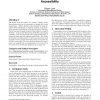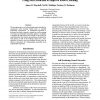2252 search results - page 80 / 451 » Improving Random Forests |
ICML
2004
IEEE
14 years 9 months ago
2004
IEEE
This paper extends previous work on the Skewing algorithm, a promising approach that allows greedy decision tree induction algorithms to handle problematic functions such as parit...
IEEEICCI
2008
IEEE
14 years 2 months ago
2008
IEEE
In this paper a novel offline signature verification scheme has been proposed. The scheme is based on selecting 60 feature points from the geometric centre of the signature and co...
DSD
2006
IEEE
14 years 2 months ago
2006
IEEE
In wireless sensor networks, the coarse grained localization is a method to compute the position of randomly distributed sensor nodes. Without optimizations, it provides low preci...
ASSETS
2007
ACM
14 years 2 days ago
2007
ACM
The World Wide Web (Web) is a visually complex, multimedia system that can be inaccessible to people with visual impairments. SADIe addresses this problem by using Semantic Web te...
FLAIRS
2008
13 years 10 months ago
2008
We investigate the use of self-predicting neural networks for autonomous robot learning within noisy or partially predictable environments. A benchmark experiment is performed in ...


